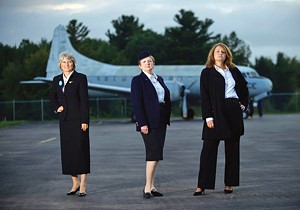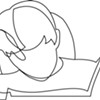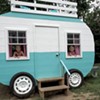Published October 5, 2011 at 11:00 a.m.
There’s a scene in the new ABC series “Pan Am” where two baby-faced pilots share a drink at a pub. The year is 1963. “Look at that table over there,” one pilot says, gesturing at four stewardesses who are laughing and drinking just like the guys. “They don’t know that they are the new breed of woman. They just had the impulse — to take flight.”
There are some very smart shows on TV these days; “Pan Am” is not one of them. Even with the guidance of executive producer and former Pan Am stewardess Nancy Hult Ganis, the series, which tells the story of young women working for the now-defunct airline in the early 1960s, gets a lot wrong — the pilots are too young, for instance, and the stewardesses’ hair is too long. But, despite its cheesy dialogue, the show gets one thing right: The Pan Am stewardesses were a new kind of woman.
And when they sashayed through airports around the world, they really did turn heads with their cool, put-together attitude and elegance.
Just ask three former Pan Am stewardesses living in Vermont, who recently gathered at San Sai in Burlington. It’s been more than 20 years since most of them worked a flight, and they’ve rarely seen one another since. But, like many former Pan Am stewardesses, they’ve been caught up in the buzz surrounding the new show — digging through old boxes, unearthing memories and reaching out to one another.
A newcomer to the Japanese restaurant can pick them out immediately. Their posture is impeccable, their style worldly. Daphne Walker, 53, has the biggest, bluest eyes you’ve ever seen, framed with a stylish silver bob. Nina Falsen, 60, wears an asymmetrical leather belt cinched artfully around her white, button-down shirt. Susan Barron, 67, is all sassy red glasses and gold earrings.
Pan Am collapsed in 1991; over the years since, air travel has devolved from modern inconvenience to logistical nightmare. (When asked how they feel about flying now, the women let out a collective groan.) Perhaps that’s why the former stewardesses remember Pan Am so fondly. The company, they agree, was terribly mismanaged. The work was grueling. Passengers could be assholes, or drunk, or both. But stewardessing beat the other career options for women in the 1960s and ’70s, they say. And it allowed them to travel the world.
Oh, and the show? These ladies weren’t impressed. But it does get one intangible right: “We thought we were special,” says Falsen, “and we kind of were.”
‘A once-in-a-lifetime opportunity’
It would be difficult not to notice the 1960s mania on TV these days. Ever since “Mad Men” arrived in 2007, our cultural obsession with the era has snowballed. It’s likely that AMC’s postponement of the series this year is exactly why other networks are clamoring to fill the void.
But why the fascination with the decade now?
In her New York Times review of “Pan Am,” Alessandra Stanley writes, “‘Mad Men,’ which returns for a fifth season next year, is unquestionably a far better show, but ‘Pan Am,’ like ‘The Playboy Club,’ which began on NBC this week, may be a more accurate reflection of our own insecurities. When the present isn’t very promising, and the future seems tapered and uncertain, the past acquires an enviable luster.”
Writer Nora Ephron offers a more cynical take in her response to “The Playboy Club,” which Gloria Steinem recently called for viewers to boycott. “It has gone back to the early 1960s, to that golden moment just before the women’s movement came along and ruined everything,” she writes sardonically in Newsweek.
Stacey Wilson of the Hollywood Reporter tells NPR’s “All Things Considered” that TV’s fascination with the 1960s is all about the visuals. “It’s one of the most glamorous, most beautiful eras in our history, but I also think it was an era of the most change for women,” she says.
It was certainly a time of change for Susan Barron. Fresh out of college in 1966, she took a job as a newspaper reporter in Gainesville, Fla. — and stayed six months. “There was so much sexism everywhere,” she recalls. “I hated it.” A right-wing editor chastised her for her liberal views and gave her “stupid assignments covering ladies’ luncheons,” she says. “And that’s really as much as women were given those days.”
When she heard Pan Am was interviewing at a nearby college campus, Barron leapt at the opportunity. She nailed the interview, proved she could speak another language (Spanish) and cheated on the eye test — stewardesses weren’t allowed to wear glasses — by memorizing the chart a friend had purloined. Once the doors were closed on board, she says, stewardesses would put on their glasses and take off their girdles.
When her parents found out she had a job with Pan Am, Barron says, they were “horrified.” She was wasting her education, they told her. Her father took the news particularly badly — he believed stewardesses were “morally loose,” says Barron.
At the time, Pan Am stewardesses were required to have college degrees and to speak at least one foreign language. (The airline flew exclusively international routes.) Since bilingual American women were in short supply, Pan Am recruited stewardesses from around the world. That’s how Nina Falsen, who was born and raised in Norway, got the job in 1973. She was nearly 21, her head filled with shimmering images of the Pan Am lifestyle when recruiters arrived in Oslo. “So glamorous! So exciting! What an adventure!” she says now.
The competition was fierce. Pan Am interviewed about 1700 young women during that visit, Falsen says, and hired 15. Why did she make the cut? Falsen spoke three foreign languages — German, which she picked up at boarding school in Vienna; Italian, from a stint as an au pair in Italy; and English, which she spoke with her British mother. Plus, she was 5-foot-6 and weighed 128 pounds, which put her comfortably within weight restrictions.
For all her previous travel experience, Falsen had flown only once before, and she’d never been to America. “I thought I’d just do it for a year,” she says.
“Everybody thought that,” Barron pipes up.
Except Daphne Walker. “I had wanted to be a stewardess from my very first flight in first grade,” she says. Still, Walker studied journalism in college and briefly aspired to be a foreign correspondent for Time magazine. One way or another, she wanted to see the world.
Walker says it was a no-brainer to drop out of college in 1979 when she learned the airlines were hiring. She was 19. “It seemed more challenging and difficult to get into the airlines,” she recalls. “It seemed like a once-in-a-lifetime opportunity.” She interviewed with TWA and Pan Am, but turned down an offer from the former because she only wanted to fly internationally.
Besides meeting all the other requirements, Walker says, stewardesses had to have the right kind of personality: “Somebody who was not going to be too challenging to authority, a nice person who they knew they could mold to what they wanted … to tell you the truth.”
Malleability was key, because regulations were strict. If stewardesses wanted to wear their hair down, it had to be at least an inch and a half above their shoulders. Those with long hair had exactly three preapproved hairstyle choices. Nail polish and “suntan” pantyhose were a must. Toe cleavage was strictly forbidden, as was eye shadow above the eyelid fold. Women who gained weight were suspended without pay. After six months’ probation, stewardesses were permitted to marry, but if they got pregnant, they were fired. (That changed in the ’80s, shortly after the term “flight attendant” began to replace “stewardess.”)
“We were always afraid of someone ‘writing you up,’” says Walker. “Being a free spirit was not exactly encouraged.”
At the top of the military-style hierarchy were pilots, who were much older than the barely thirtysomething guys on the ABC show. All of them were military trained, and most had served in World War II, Korea or Vietnam.
The captain, Walker says, “was the sky god.” Among the crew, however, the lead stewardess, or purser, set the tone. She could write up crewmates and kick unruly passengers off the plane, but that’s about as far as her authority reached. On layovers, she’d still have to share a hotel room with another stewardess, while pilots and other male crew members got their own.
So, are the stereotypes true? Were stewardesses always sleeping with pilots? The former Pan Am-ers laugh and scrunch up their noses. Falsen remembers the pilots as old and cheap. When crew members went out to dinner together on a layover, “We’d have a salad, and they’d have a steak, and they’d want to split the bill,” she says. “Most of them were jerks.”
‘They complained about everything, and we were locked up with them.’
By the time Walker began at Pan Am in 1979, she and her colleagues were skeptical about the airline’s storied glamour. “Have you found it yet?” they’d ask each other jokingly. Even for Barron and Falsen, who were there in Pan Am’s heyday, the job could be dirty, thankless and excruciating.
That requirement to wear nail polish? “They didn’t want to see the roast beef under your fingernails,” says Falsen. The galleys were “disgusting,” she adds, often infested with rats and cockroaches.
And then there were just your regular passengers. “They complained about everything, and we were locked up with them,” says Walker. Often they treated the stewardesses like bimbos. Barron remembers the incredulous look a man gave her when she commented on the Thomas Jefferson biography he was reading. “People like you don’t read books like this!” he said.
During one flight, Barron recalls, she felt something strange on the back of her legs every time she passed a certain row. A fellow stewardess saw what was going on and told Barron, “The woman in the back row is flipping up the back of your skirt,” she recalls.
Barron confronted the woman, who giggled and confessed that she wanted to see what Barron was wearing underneath. “She just didn’t see me as a human being,” Barron says. “I was just this Barbie doll walking down the aisle.”
The entire crew was exhausted on flights. “Sometimes we’d go into the cockpit and find everybody asleep,” says Barron. After stewardesses had completed their service on lengthy direct flights, such as the 13-hour one to Tokyo, they faced hours of nothingness. “The length of a 747 is the length of a football field,” says Walker. “So I’d walk it over and over, like I was on a track. Because if I sat down, I’d fall asleep.”
If the captain and purser were laid back enough, they would turn a blind eye when stewardesses slipped off to dark corners to nap. Walker knew all the secret places to sleep on a 747, such as on the floor behind the last row of seats in the upstairs first-class lounge. Unfortunately, that ended when passengers discovered her spot, and “the first-class passengers and flight attendants started sleeping on the floor together,” says Walker.
When the pilots were amenable, she’d just sleep in the cockpit.
‘Queen of the skies’
Spurts of excitement kept their energy up. “You never knew who was going to be on your flight,” says Walker. She had Peter O’Toole, Maria Shriver and Prince, who changed his outfit several times during the flight and insisted on talking through an assistant seated beside him. “Would Prince like another glass of wine?” Walker had to ask the assistant.
Falsen was on a flight chartering James Brown and his bandmates to and from Gabon. She stayed for a week, hanging out at the hotel pool, partying with the Godfather of Soul.
“One of the biggest SOBs I’ve ever met was Walter Cronkite,” says Barron. “He was demanding and rude.” She had a better experience with Nancy Sinatra. “Her daughter spilled a Coke on her pants, and she was just as nice as she could be,” Barron recalls. And she’ll never forget Steve McQueen, who pointed to an offering on the dessert tray and said, to Barron’s horror, “I’ll have the one with the pubic hair on it.”
Yes, there were dessert trays, white tablecloths and caviar, but Pan Am often flew grittier missions. In the TV show, a flight is diverted to Cuba to evacuate survivors of the Bay of Pigs crisis. This kind of flight, say the Vermont former stewardesses, was fairly common.
“[The TV version] seemed a little overly dramatic,” says Falsen, “but we did do those things.” She helped airlift Americans out of Tehran after the Shah was deposed in 1979. The crew flew in with an empty 747 and left filled way beyond capacity. “We had people in the toilets,” Falsen says.
Stewardesses weren’t required to participate in rescue missions, though. “I was always looking for trouble, so I volunteered,” says Falsen.
Pan Am, which was building airports and developing international routes as early as the 1920s, was more than a commercial airline. Barron says the company thought of itself as a mini state department. “That was part of its demise,” she says. “It was an extremely arrogant airline that actually thought it was queen of the skies.”
Still, terrorism was always a threat. “Planes were always getting hijacked,” says Walker. During her tenure, stewardesses were required to look under seats for explosives before takeoff. “And we’d think, What if it blows up in our faces?” she recalls. “But we were very expendable.”
When jets took down the World Trade Center on September 11, 2001, “I don’t think any of us were surprised,” says Walker. “We think of the world as tumultuous now, but it’s always been tumultuous.”
‘A fur-lined rut’
For all of the ABC show’s flaws, Falsen says that when she watched it, she could relate to “prancing through the airport and the terminal in my high heels, sort of decked out. People would look because we looked so sharp.”
As for the strictly regulated stewardess image, Falsen “bought into it,” she says. “I really thought I was hot stuff. I thought I had sex appeal, and I used it.” Most of the stewardesses did, she notes. “I suppose we were feminists, but we still used our sexuality.”
Unlike Walker and Barron, who both say they have been hesitant to discuss their Pan Am years at length with people who know them now, Falsen says being a stewardess was never something she wanted to hide. Her husband still brags about her glamorous past.
In her day, Falsen says, stewardesses would sit down to talk with passengers and play with their kids. In first class, the atmosphere was especially refined. “It wasn’t servile,” she says. “I felt like I was hosting a dinner party.”
Still, the glamour and perks — including a month’s vacation, hotel discounts and free travel around the world — came with drawbacks. Barron calls it “a fur-lined rut.” Besides the exhaustion and the needy passengers, flying for a living could get lonely. It was difficult to maintain relationships on the ground, the women say, and even in the air. “Sometimes you’d fly with three of the same people for a month, and then you’d never see them again in your life,” says Walker.
The lifestyle, says Falsen, was “addictive,” and they all agree it was difficult to envision their future without flying. “I couldn’t imagine doing anything as interesting,” Falsen says. “Why would I go back to Norway? To be a secretary?”
Life after Pan Am
But they all did find something else.
Four days before Christmas 1988, Pan Am Flight 103 exploded over Lockerbie, Scotland, killing all 259 people on board, plus 11 on the ground. “It was the beginning of the end for Pan Am,” says Barron. She had known the pilot and flown that route — from London’s Heathrow to New York’s John F. Kennedy International — many times, and says she was overcome with survivor’s guilt.
The crash was the nail in Pan Am’s coffin, the Vermont stewardesses say, but all three were itching to leave even before that tragedy. In the late ’80s, the company was struggling financially and began offering buyouts so it could replace its workforce with cheaper labor.
“The airlines were dragged kicking and screaming into the 21st century,” Barron says. “They were so backwards in so many ways.” The medical kit Pan Am had on board, for example, was filled with nothing but Band-Aids and smelling salts. What the crew really needed was a defibrillator, says Barron. “I had people die on flights,” she says. “I had people have heart attacks.” In the airline’s top-down system, no one would listen to the stewardesses’ suggestions.
Still, on the final Pan Am flight from Tokyo, “everybody was in tears,” Barron recalls, including herself. An era had ended, and she was left wondering how she and her fellow stewardesses would make a living post-Pan Am.
“We all thought we didn’t have any transferable job skills,” says Barron, “because we were told we had no skills.” They were experts at “thinking on your feet at 30,000 feet,” she says — catching a cat running loose in the overhead; calming passengers who’d found a bat in the cabin. But how would that experience translate to a résumé, especially during a recession?
During many flights, Walker recalls wondering, Is there something more that I could be doing? But it was a tough transition after she took the buyout. “I had, like, a physical longing, an addiction to travel,” she says.
So she went back to school. Turns out those skills amounted to quite a bit more than she had thought. Walker is now a career counselor at Champlain College. Falsen, who also returned to school, became a psychotherapist and now lives in Charlotte. (Pan Am was “great training,” she jokes. “Lots of hand-holding.”)
Barron, who worked for a while in marketing with her first husband, is now a real estate agent in Rochester. When Tropical Storm Irene tore through her town, Barron snapped right into stewardess mode, Walker says, helping with recovery efforts everywhere she could. “I was going a little crazy with the inefficiency of it all,” Barron says, flashing the gracious but slightly exasperated smile of a veteran flight attendant.
There are precious few people in the world who share that Pan Am experience, though this group of Vermonters who flew out of JFK was small enough to keep tabs on one another over the years. “I suppose it’s like emergency-room workers or firefighters,” says Walker. “You have this amazing experience with people, and then you never see them again.”
That is, of course, until a major television network creates a series around that rarefied experience. Pan Am may be gone, but the women who made it legendary are still soaring.
More By This Author
Speaking of Culture
-

Video: Musicians Jeremiah and Annemieke McLane Move into their New Home
Mar 24, 2022 -

Creating Art That Celebrates the Culture and Climate of Places Around the Globe
Jun 29, 2021 -

Video: Storyteller Ferene Paris Meyer Inspires a Juneteenth Mural
Jun 17, 2021 -

Arts and Culture Nonprofits to Receive $5 Million in State Relief Grants
Jul 7, 2020 -

18 Elm in Waterbury Creates Community at the Table
Jul 9, 2019 - More »
Comments
Comments are closed.
From 2014-2020, Seven Days allowed readers to comment on all stories posted on our website. While we've appreciated the suggestions and insights, right now Seven Days is prioritizing our core mission — producing high-quality, responsible local journalism — over moderating online debates between readers.
To criticize, correct or praise our reporting, please send us a letter to the editor or send us a tip. We’ll check it out and report the results.
Online comments may return when we have better tech tools for managing them. Thanks for reading.













































